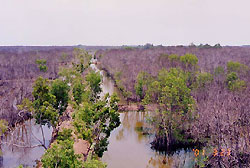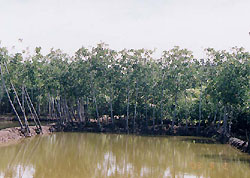| Period: 4 April - 25 May 2003. Country: Indonesia
(Makassar) |
| A Comparative Study to Seek for Sustainable Implementation
of Silvo-Fishery Systems in Coastal Areas in Indonesia. |
| Andi Amri (Division
of Southeast Asian Area Studies) |
| Key Words: Silvo-Fishery System,
Mangrove Plantation, Coastal Aquaculture, Coastal Resource Management,
Indonesia |
Due
to the expansion of various kinds of human impacts, a number of
biological resources came to have been unsustainably exploited in
many ecosystems in the world. Distinction of mangrove forests is
one of the most important and urgent issues among them. In particular,
in Southeast Asia, expansion of shrimp culture is thought to have
been the most important impact on mangrove disappearance. Under
such circumstances, silvo-fishery system, a combination of mangrove
plantation with coastal aquaculture, has been implemented in Indonesia,
Malaysia, Vietnam, Thailand and the Philippines.
A comparative
study was carried out in order to analyze the sustainability of
silvo-fishery systems of mangroves and aquaculture in some selected
places in Indonesia: Cikiong, West Java, where the social forestry
program, in particular silvo-fishery system, was first implemented
in Indonesia; Cokke, Sinjai District of South Sulawesi, where the
district government adopted the Cikiong model in collaboration with
the former leader of ACI group (Aku Cinta Indonesia or
I Love Indonesia); Bakko of Sinjai District; and Bontotanga of Maros
District in South Sulawesi.
Silvo-fishery
system sounds to be a suitable and better measures for managing
coastal resources such as mangrove forests and fishponds. However,
it is not always true that the system provides harmonized conditions
between them. For example, the model adopted in Cikiong and Cokke
seems to be not so sustainable as expected because of less profitability
in generating local peoples' income. In case of this model, the
government has paid more attention to environmental conservation
than economic development, and this reflects on the land ratio of
8:2 devoted to mangroves and fishpond/ditches, respectively.
Following
the introduction to Cokke, the Forestry Department of Maros District
extended this system to the District's coastal region in collaboration
with local people. Although the initial stage of reforestation saw
the harmonic collaboration between the government and the villagers,
some villagers recently began to take off the seedlings because
the system was not able to improve the productivity of fishponds.
Besides, some of the villagers claim that the plantation disturbs
the work for harvesting fish and shrimps.
Taking
such circumstances into consideration, this study came to note that
the silvo-fishery system established in Bakko of Sinjai District,
in which mangrove forests were only kept on the fishpond dikes and
the outermost fringes of the fishpond areas, seems to be more sustainable
model for integrating mangrove plantation and coastal aquaculture.
 |
|
 |
| The heavy flood in 1999
caused the damage of mangroves in Cikiong, West Java. |
The remaining mangroves at the fishpond
dikes in Bakko, South Sulawesi |
|



 21st Century COE Program
-Aiming for COE of Integrated Area Studies-
21st Century COE Program
-Aiming for COE of Integrated Area Studies-